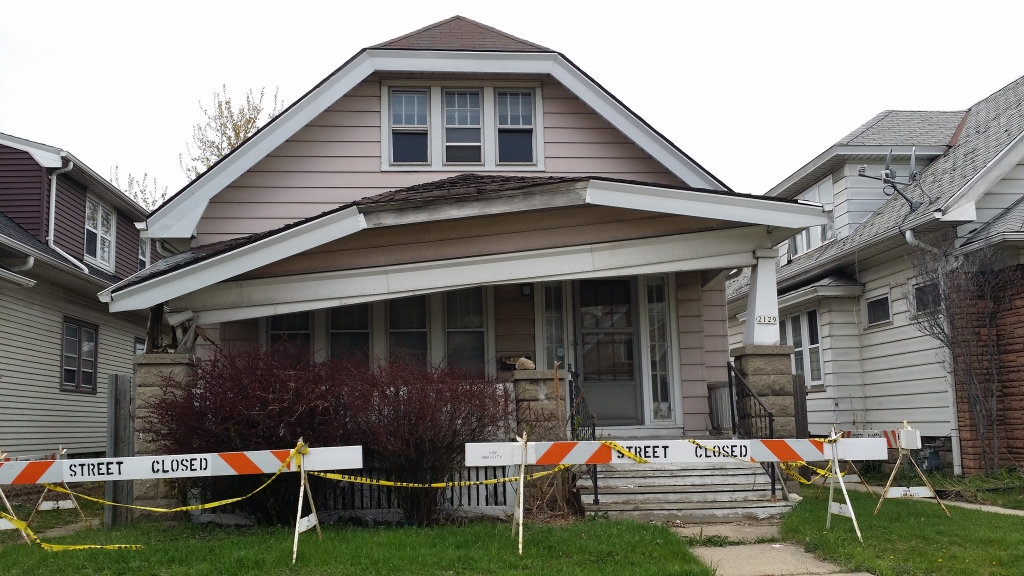New Mobile App Pinpoints Housing Hazards
Community groups using new app, which uses crowdsourcing to inventory and map all neighborhood housing issues.

An abandoned South Side house was photographed with the Vacant Voices app. (Photo courtesy of Shantanu Singh)
Organizations working to alleviate the urban housing crisis of the last decade, generally strapped for funds and manpower, need help doing more with less. Milwaukee lawyer Shantanu Singh began to see this first in his work as an assistant attorney general of Illinois assigned to work on mortgage fraud, a couple years after graduating from the University of Wisconsin Law School in 2004.
“(One) issue with the foreclosure crisis and the recession is that vacant and abandoned properties are in such high volume and there’s such a large inventory that organizations don’t have the capacity to address the problem,“ Singh said.
Noting that collecting and analyzing data is “labor intensive and subject to data entry error,” Singh was inspired to find a better way to perform these tasks. Educating himself in technology basics and working with a group of developers, Singh created “Vacant Voices,” an easy-to-use app for mobile devices to collect field data on housing inventory in a given geographic area.
“My curiosity just led me to the solution,” Singh said. “I’ve always had an interest in technology. I became more interested when I started advising some clients who rely upon technology a lot and I saw the power of automating processes and making work more efficient.“
Singh launched the app in April and organizations in Milwaukee and other cities are piloting it. Harambee Great Neighborhood Initiative (HGNI) and Riverworks Development Corp., two of 11 coalition partners working together to strengthen the North Side neighborhoods, are among the first users. Young adult volunteers for HGNI conducted a survey of more than 500 houses using the Vacant Voices app last fall.
“(Singh) worked with us to customize the app and the survey to the types of questions and the type of information we needed to gather,” said Leif Otteson, HGNI organizer.
The app provides a checklist of potential problems with a house and, once filled out on a smart phone or tablet, the results are loaded into a database. Survey volunteers are prompted to use the app to take photographs to limit subjectivity. All of this is done and executed by the program in five minutes per property, Singh explained.
The purpose of HGNI’s survey was to discover where the properties with the most need were located and figure out how to deal with them, explained Otteson. The houses in the worst condition were generally foreclosed, vacant homes that were owned by a bank or the city, and HGNI used the survey to inform the city which properties posed hazards and needed to be demolished.
“That was a big benefit because the city looks toward a lot of organizations like ours for that ‘boots-on-the-ground’ information about some of the properties that are out there,” Otteson said.
The app allows organizations to analyze the data collected and see where problems are most concentrated. That, in turn, helps them prioritize areas of a neighborhood that need greater investment, rather than investing randomly across a larger geographic area. And that kind of targeted investment can be effective in turning a neighborhood around, Singh explained.
In addition, such data can help organizations focus on where to do community outreach and how to connect residents to funds that may be available to strengthen a neighborhood’s appearance. Singh added that he expects neighborhood organizations that have gathered data using Vacant Voices to see positive results from strong data-based grant applications and community plans.
Otteson noted that although the app might still be improved, his organization had a great experience with it and recommends it to other organizations. “Shantanu did a great job of following up with us and helping us compile that data into a usable form, which is uploaded to a spreadsheet. We were able to sort everything by address and analyze everything that we have,” he said.
Layton Boulevard West Neighbors also piloted the Vacant Voices app. Neighborhood Plan Coordinator Daniel Adams and a neighborhood leader tested the app on several vacant homes. Noting that LWBN is currently focused on other projects, Adams said Vacant Voices “could be a useful tool for the right group in the right situation.”
This story was originally published by Milwaukee Neighborhood News Service, where you can find other stories reporting on fifteen city neighborhoods in Milwaukee.






















